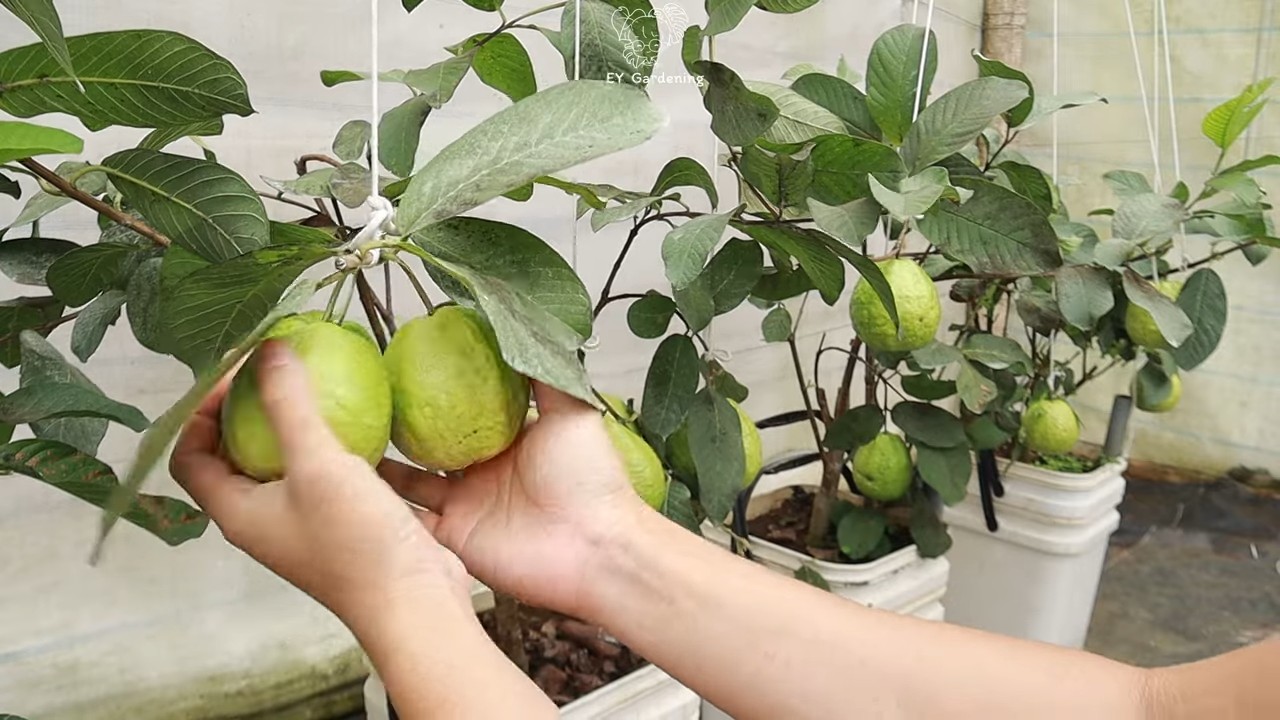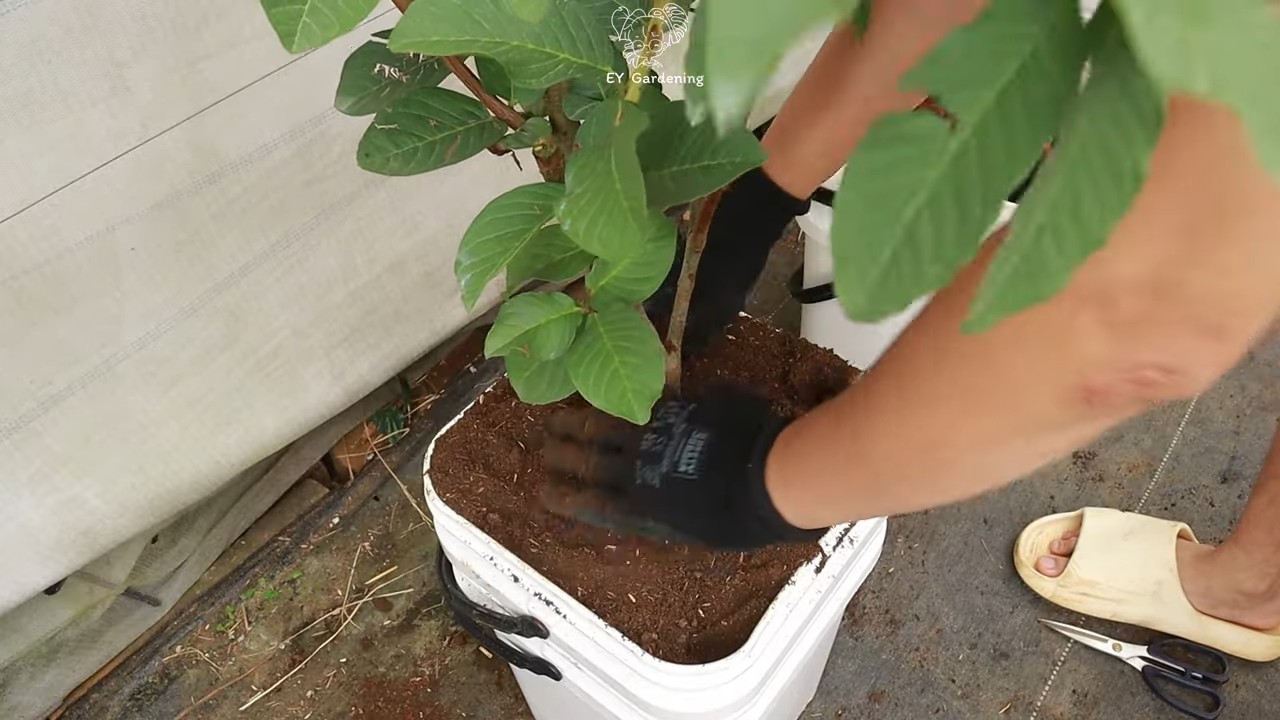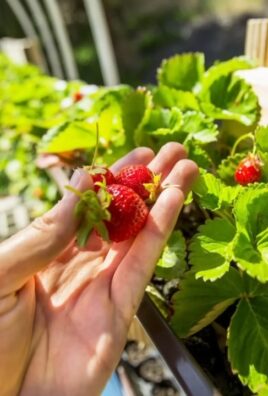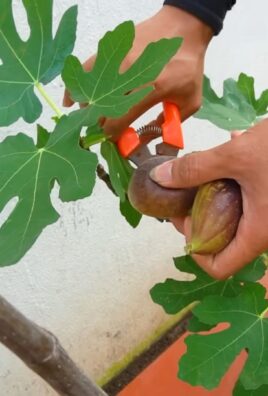Rooftop Guava Tree Growing might sound like a tropical dream reserved for sprawling orchards, but guess what? It’s totally achievable, even if your “garden” is a sunny patch on your apartment building! I’m so excited to share some amazing DIY tricks that will have you harvesting your own sweet, juicy guavas right from your rooftop oasis.
Guava trees have a rich history, deeply intertwined with cultures across the globe. Originating in tropical America, they’ve been cherished for centuries, not just for their delicious fruit, but also for their medicinal properties. Imagine bringing that legacy to your own home!
Why should you embark on this rooftop guava adventure? Well, for starters, fresh, homegrown guavas taste infinitely better than anything you’ll find in the store. Plus, think of the bragging rights! But more importantly, in urban environments, access to fresh, healthy produce can be limited. Rooftop Guava Tree Growing offers a fantastic way to connect with nature, reduce your carbon footprint, and enjoy the satisfaction of nurturing your own food source. This DIY guide will walk you through everything you need to know, from choosing the right variety to providing the perfect care, ensuring your rooftop guava tree thrives and rewards you with a bountiful harvest. Let’s get started!

Rooftop Guava Tree: My DIY Guide to Tropical Paradise Above the City
Okay, so you want to grow a guava tree on your rooftop? Awesome! I did it, and trust me, the sweet reward of homegrown guavas is totally worth the effort. It’s not as daunting as it sounds, but it does require some planning and commitment. This guide will walk you through everything, from choosing the right variety to dealing with potential problems. Let’s get started!
Choosing the Right Guava Variety
First things first, not all guava trees are created equal, especially when it comes to rooftop gardening. You need to consider size, hardiness, and fruiting habits. Here’s what I learned:
* Dwarf Varieties are Your Best Friend: Forget about those towering guava trees you see in orchards. On a rooftop, space is precious. Look for dwarf or semi-dwarf varieties. These stay smaller, making them manageable in containers. Some popular choices include:
* ‘Ruby Supreme’: Known for its pink flesh and sweet flavor.
* ‘Mexican Cream’: A yellow-fleshed variety with a creamy texture.
* ‘Patillo’: A small, prolific fruiter.
* Self-Pollinating is Key: Unless you want to hand-pollinate (which, let’s be honest, is a pain), choose a self-pollinating variety. This means the tree can fertilize itself and produce fruit without needing another guava tree nearby.
* Consider Your Climate: Guavas are tropical and subtropical plants, so they thrive in warm climates. If you live in an area with cold winters, you’ll need to choose a cold-hardy variety or be prepared to bring your tree indoors during the colder months. ‘Mexican Cream’ is generally considered more cold-hardy than some other varieties.
* Disease Resistance: Look for varieties that are known to be resistant to common guava diseases. This will save you a lot of headaches down the road.
Gathering Your Supplies
Before you even think about planting, you need to gather all your supplies. Trust me, having everything on hand will make the process so much smoother.
* Large Container: This is crucial. Your guava tree will need plenty of room to grow. Choose a container that’s at least 24 inches in diameter and 24 inches deep. Make sure it has drainage holes!
* High-Quality Potting Mix: Don’t skimp on the potting mix. Use a well-draining mix specifically formulated for containers. I like to use a mix of potting soil, compost, and perlite.
* Guava Tree Sapling: Purchase a healthy sapling from a reputable nursery. Look for a tree that’s well-branched and free from pests and diseases.
* Slow-Release Fertilizer: Guava trees are heavy feeders, so you’ll need to fertilize them regularly. A slow-release fertilizer will provide a steady supply of nutrients over time.
* Watering Can or Hose: You’ll need a way to water your tree regularly.
* Pruning Shears: For shaping and maintaining your tree.
* Mulch: To help retain moisture and suppress weeds.
* Optional:
* Trellis or support structure (if needed for your variety).
* Soil moisture meter.
* pH testing kit.
Planting Your Guava Tree
Okay, now for the fun part! Planting your guava tree is relatively straightforward.
1. Prepare the Container: Make sure your container is clean and has adequate drainage holes. Add a layer of gravel or broken pottery to the bottom of the container to improve drainage.
2. Fill with Potting Mix: Fill the container about two-thirds full with your potting mix.
3. Remove the Sapling from its Container: Gently remove the guava tree sapling from its nursery container. Be careful not to damage the roots. If the roots are tightly bound, gently loosen them with your fingers.
4. Position the Sapling: Place the sapling in the center of the container, making sure the top of the root ball is level with the surface of the potting mix.
5. Fill with Remaining Potting Mix: Fill the rest of the container with potting mix, gently firming the soil around the base of the tree.
6. Water Thoroughly: Water the tree thoroughly until water drains out of the drainage holes. This will help settle the soil and hydrate the roots.
7. Add Mulch: Apply a layer of mulch around the base of the tree, keeping it a few inches away from the trunk. This will help retain moisture and suppress weeds.
Caring for Your Rooftop Guava Tree
Once your guava tree is planted, it’s time to focus on providing it with the care it needs to thrive.
Watering
* Water Regularly: Guava trees need consistent moisture, especially during the growing season. Water deeply whenever the top inch of soil feels dry to the touch.
* Avoid Overwatering: While guavas need moisture, they don’t like to sit in soggy soil. Overwatering can lead to root rot. Make sure your container has good drainage.
* Adjust Watering Based on Weather: During hot, dry weather, you’ll need to water more frequently. During cooler, wetter weather, you can water less often.
Fertilizing
* Fertilize Regularly: Guava trees are heavy feeders and need regular fertilization to produce abundant fruit.
* Use a Balanced Fertilizer: Use a balanced fertilizer with equal amounts of nitrogen, phosphorus, and potassium (e.g., 10-10-10).
* Follow the Instructions: Follow the instructions on the fertilizer label carefully. Over-fertilizing can damage your tree.
* Fertilize During the Growing Season: Fertilize your guava tree every 4-6 weeks during the growing season (spring and summer). Reduce or stop fertilizing during the dormant season (fall and winter).
Pruning
* Prune Regularly: Pruning is essential for maintaining the shape and size of your guava tree, as well as promoting fruit production.
* Prune in Late Winter or Early Spring: The best time to prune guava trees is in late winter or early spring, before new growth begins.
* Remove Dead, Damaged, or Diseased Branches: Start by removing any dead, damaged, or diseased branches.
* Thin Out the Canopy: Thin out the canopy to allow for better air circulation and sunlight penetration. This will help prevent diseases and promote fruit ripening.
* Shape the Tree: Shape the tree to your desired form. You can prune it to be more compact or to encourage a specific growth habit.
* Remove Suckers: Remove any suckers that grow from the base of the tree. These suckers will steal nutrients from the main tree.
Sunlight
* Full Sun is Best: Guava trees need at least 6-8 hours of direct sunlight per day to thrive. Choose a location on your rooftop that receives plenty of sunlight.
* Protect from Intense Heat: While guavas love sun, they can be susceptible to sunburn in extremely hot climates. If you live in a very hot area, you may need to provide some afternoon shade during the hottest part of the day.
Pest and Disease Control
* Monitor Regularly: Regularly inspect your guava tree for signs of pests and diseases.
* Common Pests: Some common pests that can affect guava trees include aphids, scale, and fruit flies.
* Common Diseases: Some common diseases that can affect guava trees include anthracnose and guava rust.
* Treat Problems Promptly: If you notice any signs of pests or diseases, treat them promptly with appropriate insecticides or fungicides.
* Organic Options: Consider using organic pest and disease control methods whenever possible. Neem oil is a good option for controlling many common pests.
* Good Air Circulation: Good air circulation can help prevent many fungal diseases.
Winter Protection
* Protect from Frost: Guava trees are sensitive to frost. If you live in an area with cold winters, you’ll need to protect your tree from frost.
* Bring Indoors: If you have a dwarf variety, you can bring it indoors during the winter. Place it in a sunny location and water it sparingly.
* Wrap the Tree: If you can’t bring the tree indoors, you can wrap it with burlap or blankets to protect it from frost.
* Mulch Heavily: Mulch heavily around the base of the tree to insulate the roots.
Pollination
* Self-Pollinating Varieties: As mentioned earlier, choosing a self-pollinating variety is the easiest way to ensure fruit production.
* Hand-Pollination (If Needed): If you have a variety that isn’t self-pollinating, you may need to hand-pollinate the flowers. Use a small paintbrush to

Conclusion
So, there you have it! Growing your own guava tree on your rooftop might seem like a tropical dream, but with a little know-how and dedication, it’s an achievable reality. This DIY project isn’t just about adding a touch of the exotic to your urban landscape; it’s about embracing sustainable practices, enjoying the freshest, most flavorful fruit imaginable, and connecting with nature in a truly unique way.
Why is this a must-try? Because store-bought guavas simply can’t compare to the sun-ripened, juicy goodness you’ll harvest from your own tree. You control the growing conditions, ensuring organic practices and avoiding harmful pesticides. Plus, the satisfaction of nurturing a plant from seedling to fruit-bearing beauty is unparalleled. Imagine stepping onto your rooftop, plucking a perfectly ripe guava, and enjoying its sweet, tangy flavor while overlooking the city. It’s an experience that elevates everyday life.
But the benefits extend beyond personal enjoyment. A rooftop guava tree contributes to a greener environment, absorbing carbon dioxide and releasing oxygen. It can also provide shade and insulation, helping to regulate your home’s temperature and reduce energy consumption. And let’s not forget the potential for sharing your bounty with friends, family, and neighbors, spreading the joy of homegrown goodness.
Ready to take your rooftop guava growing to the next level? Consider these variations:
* **Experiment with different guava varieties:** Explore pink guavas, white guavas, or even the less common strawberry guava for a diverse flavor profile.
* **Companion planting:** Introduce herbs like basil or mint around your guava tree to deter pests and enhance its growth.
* **Vertical gardening:** Utilize trellises or other vertical structures to maximize space and create a stunning green wall effect.
* **Grafting:** If you’re feeling adventurous, try grafting different guava varieties onto a single rootstock for a multi-flavored tree.
Ultimately, the success of your rooftop guava tree depends on your commitment and attention to detail. But with the right knowledge and a little bit of love, you can transform your rooftop into a thriving tropical oasis.
We wholeheartedly encourage you to embark on this rewarding DIY journey. Don’t be afraid to experiment, learn from your mistakes, and adapt the techniques to suit your specific environment. And most importantly, share your experiences with us! We’d love to hear about your successes, challenges, and any unique tips you discover along the way. Post photos of your guava tree, share your favorite guava recipes, and connect with fellow rooftop gardeners in the comments section below. Let’s create a community of urban farmers who are passionate about growing their own food and making a positive impact on the world. So, grab your gardening gloves, gather your supplies, and get ready to experience the joy of rooftop guava growing! The sweet taste of success awaits you.
Frequently Asked Questions (FAQ)
1. What is the best type of guava tree to grow on a rooftop?
The best type of guava tree for rooftop growing is typically a dwarf or semi-dwarf variety. These varieties are naturally smaller and more manageable in containers. Some popular choices include ‘Ruby Supreme,’ ‘Mexican Cream,’ and ‘Red Indian.’ These varieties are known for their delicious fruit and relatively compact size. Consider the climate in your area when selecting a variety, as some are more cold-hardy than others. Researching the specific needs of each variety will help you make the best choice for your rooftop garden.
2. What size container do I need for a rooftop guava tree?
A mature guava tree needs a substantial container to thrive. We recommend a container that is at least 24 inches in diameter and 24 inches deep. Larger is generally better, as it provides more room for the roots to grow and helps retain moisture. Ensure the container has adequate drainage holes to prevent waterlogging, which can be detrimental to the tree’s health. Consider using a lightweight container material, such as plastic or fiberglass, to reduce the overall weight on your rooftop.
3. What type of soil is best for growing guava trees in containers?
Guava trees prefer well-draining soil that is rich in organic matter. A good potting mix for guava trees should consist of a blend of peat moss, perlite, and composted bark. This combination provides good drainage, aeration, and nutrient retention. Avoid using garden soil, as it can be too heavy and compact in containers. You can also amend the potting mix with slow-release fertilizer to provide a steady supply of nutrients to the tree.
4. How often should I water my rooftop guava tree?
Watering frequency depends on several factors, including the climate, the size of the container, and the age of the tree. Generally, you should water your guava tree when the top inch of soil feels dry to the touch. During hot, dry weather, you may need to water daily. In cooler, wetter weather, you may only need to water once or twice a week. Avoid overwatering, as this can lead to root rot. Ensure the container has good drainage to prevent water from pooling at the bottom.
5. How much sunlight does a rooftop guava tree need?
Guava trees thrive in full sun, which means they need at least 6-8 hours of direct sunlight per day. Choose a location on your rooftop that receives ample sunlight throughout the day. If your rooftop is partially shaded, try to position the tree where it will receive the most morning sun, as this is generally the strongest. Insufficient sunlight can lead to reduced fruit production and weaker growth.
6. How do I fertilize my rooftop guava tree?
Guava trees are heavy feeders and benefit from regular fertilization. Use a balanced fertilizer with a ratio of 10-10-10 or 14-14-14. Apply the fertilizer according to the manufacturer’s instructions, typically every 2-3 months during the growing season (spring and summer). You can also supplement with organic fertilizers, such as compost tea or fish emulsion, to provide additional nutrients and improve soil health. Avoid over-fertilizing, as this can burn the roots.
7. How do I protect my rooftop guava tree from pests and diseases?
Regularly inspect your guava tree for signs of pests and diseases. Common pests include aphids, scale, and fruit flies. You can control these pests with insecticidal soap, neem oil, or by introducing beneficial insects, such as ladybugs. Diseases, such as anthracnose and root rot, can be prevented by ensuring good air circulation, proper drainage, and avoiding overwatering. Prune any diseased or damaged branches promptly.
8. How do I prune my rooftop guava tree?
Pruning is essential for maintaining the shape and size of your rooftop guava tree, as well as promoting fruit production. Prune in late winter or early spring, before new growth begins. Remove any dead, diseased, or crossing branches. Thin out the canopy to improve air circulation and sunlight penetration. You can also prune to shape the tree and encourage branching. Avoid pruning too heavily, as this can reduce fruit production.
9. How long does it take for a rooftop guava tree to bear fruit?
The time it takes for a guava tree to bear fruit depends on the variety, the age of the tree, and the growing conditions. Generally, guava trees grown from seed can take 3-5 years to bear fruit. Grafted trees, on the other hand, can start producing fruit within 1-2 years. Providing optimal growing conditions, such as ample sunlight, regular watering, and fertilization, can help accelerate fruit production.
10. Can I grow a guava tree indoors if I don’t have a rooftop?
While it’s possible to grow a guava tree indoors, it can be challenging to provide the necessary conditions for optimal growth and fruit production. Guava trees need a lot of sunlight, which can be difficult to provide indoors, even with grow lights. Additionally, indoor environments tend to be drier, which can stress the tree. If you choose to grow a guava tree indoors, select a dwarf variety, provide ample sunlight, and maintain high humidity levels.





Leave a Comment